5.5: Grammatical Dependencies
- Page ID
- 112738
5.5.1 From 8.9 The Operation MOVE, in Anderson's Essentials of Linguistics
Video Script
We’ve developed a model of the mental grammar that says that we draw words, morphemes, and morphosyntactic features from our mental lexicon, and then the operation MERGE combines all these items into a grammatical x-bar structure. In this unit, we’re going to look at another operation of the mental grammar, called MOVE, which takes a part of a sentence and moves it somewhere else in the sentence. But why would we want to do that? Let’s look at some examples to figure it out.
Let’s take our now-familiar sentence, Ann hopes that the Leafs will win. Hope is one of those verbs that takes a whole clause as its complement, and that clause is introduced by the complementizer that in C-head position. But what if Ann isn’t hoping, what if she’s asking whether there’s any possibility of her hopes being realized? If she’s asking instead of hoping, the complementizer that doesn’t work as well here. It’s grammatical if we use the complementizer if. I’m going to suggest that the reason the complementizer that doesn’t fit very well in this position is because the verb head ask doesn’t just subcategorize for a complement clause — it’s even pickier than that! The verb ask subcategorizes for a question clause. And the difference between a regular complement clause and a question clause is that a question clause has a [+Q] feature in the C-head position.
So we’re seeing another instance of a morphosyntactic feature occupying a head position. The strange thing about features is that they don’t get pronounced. We know that morphemes and words link up a form (either spoken or written) with a meaning. But features have meaning and don’t have any form of their own. The tense feature does its job by making sure that its complement has the right form. And one way that the [+Q] feature does its job is by making sure that the thing in the C-head has the right form. So if is ok when the C-head has a [+Q] feature in it, but that is not so good.
There’s another way that the [+Q] feature can make itself noticed, though. In English, if we want to ask a question, we don’t do it like this: If the Leafs will win? How do we form that question when it’s not embedded inside another clause? Of course, it’s Will the Leafs win? How did that modal will get from its position between the subject and the main verb up to the beginning of the sentence? Here’s where the operation MOVE comes in.
The theory claims that the operation MERGE generates this structure for the question. This looks just like the declarative sentence, The Leafs will win, except that it has a [+Q] feature in the C-head position. That [+Q] feature needs people to know that it’s there; it’s not like the null complementizer that doesn’t mind being silent: it changes the meaning of the sentence so it wants to be pronounced. For questions that are main clauses themselves, it’s not grammatical in English to just stick a question complementizer into the C-head position. So instead, the operation MOVE comes along, picks up the modal from the T-head position, and moves it up to the C-head position.
But when the modal moves from T up to C, the T position doesn’t disappear from the tree. Instead, the thing that moved leaves behind a little footprint or shadow of where it used to be. In the theoretical literature, it’s called a “deleted copy” or a “trace” — the idea is that it’s still there in the T-head position in our mind, even though we pronounce it up in the C-head position.
Notice that now we’ve got two levels of representation in our syntax. MERGE generates the underlying form of a sentence, what we’ll call the Deep Structure. And then MOVE comes along and, well, moves things, to give us the Surface Structure. A lot of the sentences that we’ve been looking at so far have the same deep structure and surface structure, but when we look at questions, we can see that a sentence can have some systematic differences in how it’s represented at the two levels.
One thing I want to point out is that when we observe sentences, and when we make grammaticality judgments to observe whether a sentence is grammatical or not, what we’re observing is always the surface structure. The Surface Structure is the form of the sentence that we speak: it’s the form that’s out there in the world. We can’t ever observe the Deep Structure; that’s the form of the sentence that exists in our minds. But some of the things that we observe about Surface Structures allow us to conclude that the Deep Structure does exist in our mind and that it’s related in a systematic and predictable way to the Surface Structure. We can represent the relationship between Deep and Surface Structure using a tree diagram.
Just to make this idea about levels of representation clearer, let’s look again at these sentences. The idea is that when these two sentences, one a question and one a declarative sentence, are generated by MERGE, they have almost the exam same Deep Structure. The only difference between their Deep Structures is that the question sentence has a [+Q] feature in C and the declarative doesn’t. The declarative sentence is pretty much ok, so it doesn’t need the MOVE operation to do anything, so its Surface Structure is the same as its Deep Structure. But the question sentence needs to get its [+Q] feature expressed, so MOVE comes along and forms a Surface Structure that’s different from its Deep Structure. So the two sentences that were almost the same in their Deep Structures have one crucial difference between them in their Surface Structures.
We saw that when a sentence has a modal in the T-head position, that modal can move up to the C-head position to support a [+Q] feature. What happens when we want to form a question from a sentence that doesn’t have a modal in the T-head position? What about a sentence like this one? Samira phoned.
We know that the T-head node has a tense feature in it. In a declarative sentence, that tense feature makes sure that the V-head in its complement has the right feature — in this case, the past tense form phoned. But we certainly don’t form a question from this sentence by asking, “Phoned Samira?” What happens in this kind of sentence is that we bring the auxiliary do into the T-head position. Because in this case the tense feature is [+past], do becomes its past-tense form did. Now that the past tense feature is on the auxiliary, it won’t be on the lexical verb, so the verb phoned in V-head just takes its bare form phone. And then to get the [+Q] feature supported, MOVE takes did from the T-head position and moves it up to the C-head position, leading to the Surface Structure, “Did Samira phone?”
Your challenge now is to think about how our mental grammar forms yes-no questions for sentences that have non-modal auxiliaries in them. What do the Deep Structure and Surface Structure look like for each one? Try to figure it out!
Check Yourself
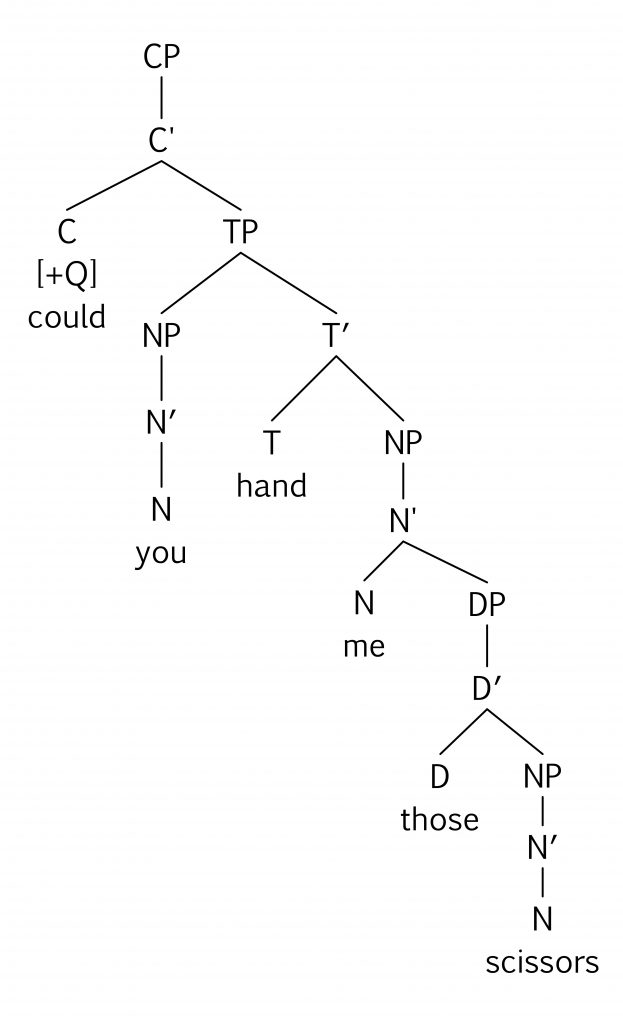
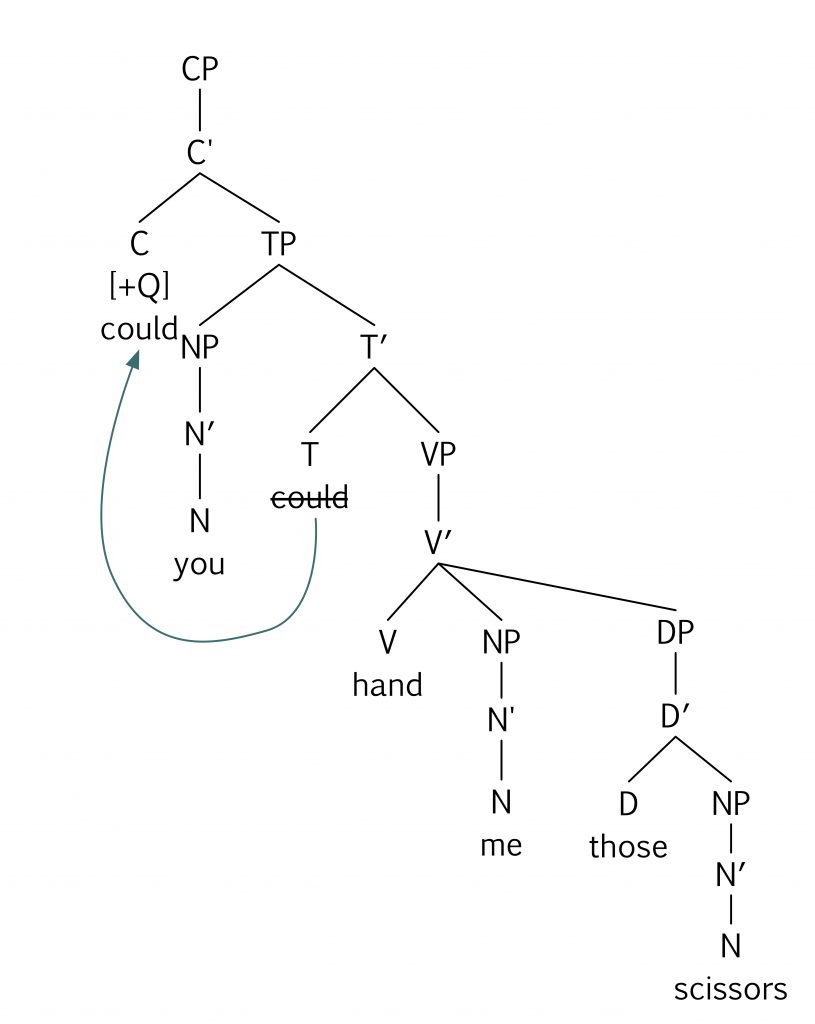
- Answer
-
The second one, with the movement of could from the T node to the C node.
The reason: This is part of forming a question, where we move the conjugated verb to the front of the phrase.
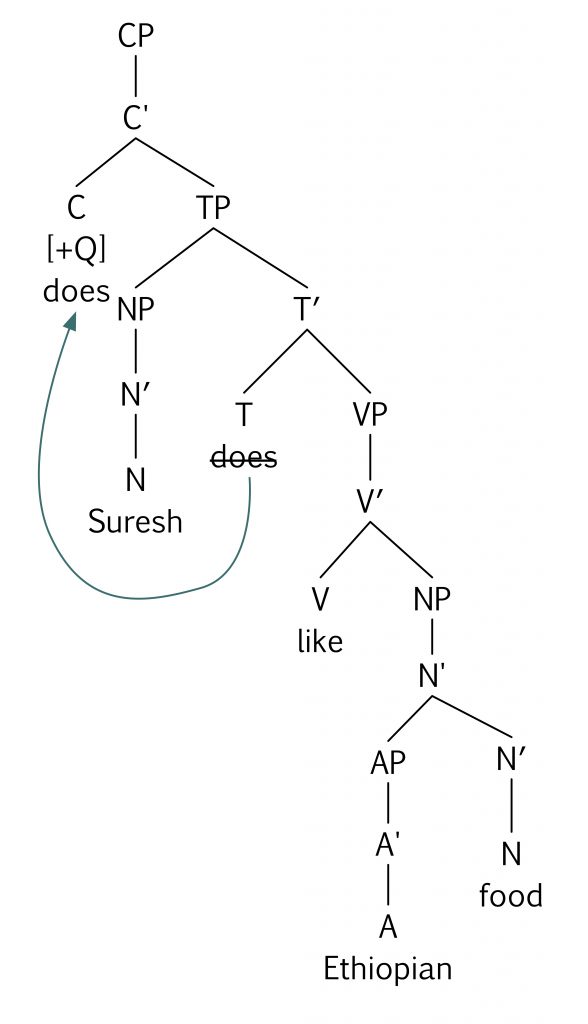
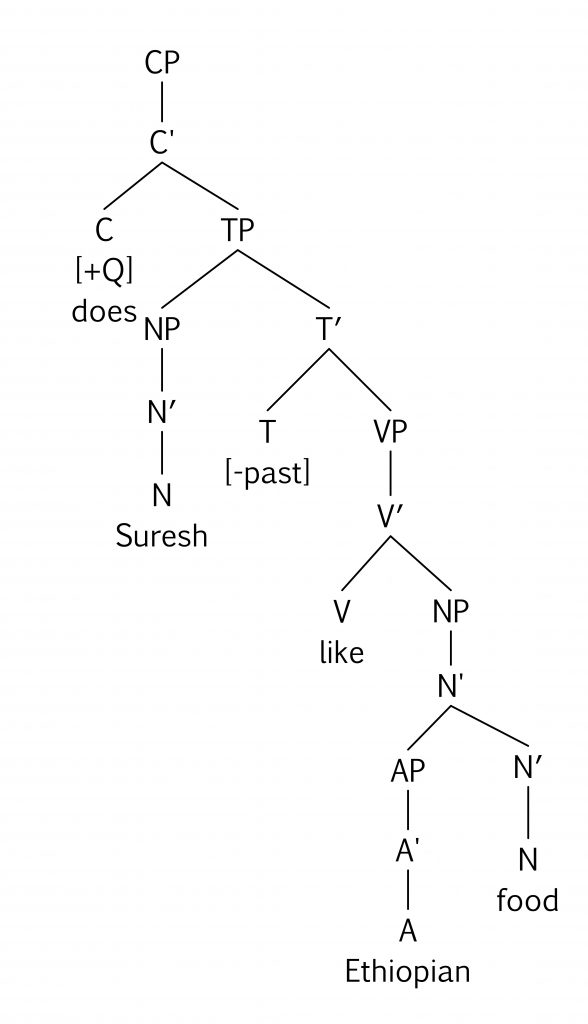
- Answer
-
The first one, with the movement of does from the T node to the C node.
The reason: This is part of forming a question, where we move the conjugated verb to the front of the phrase.
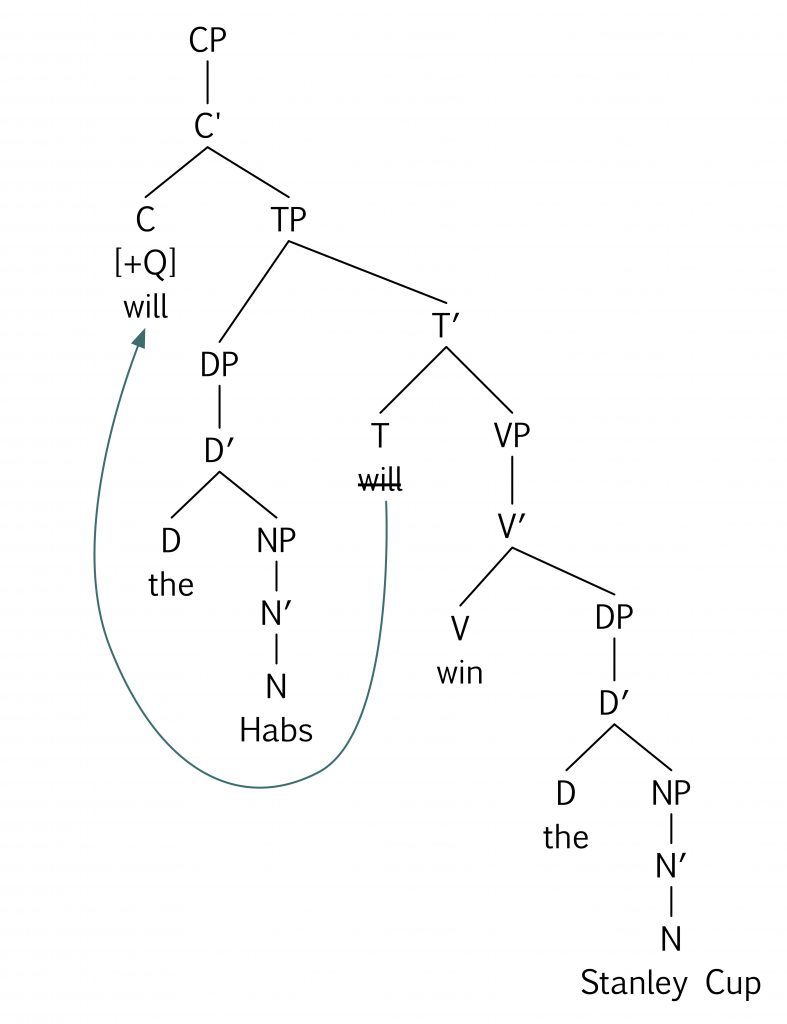
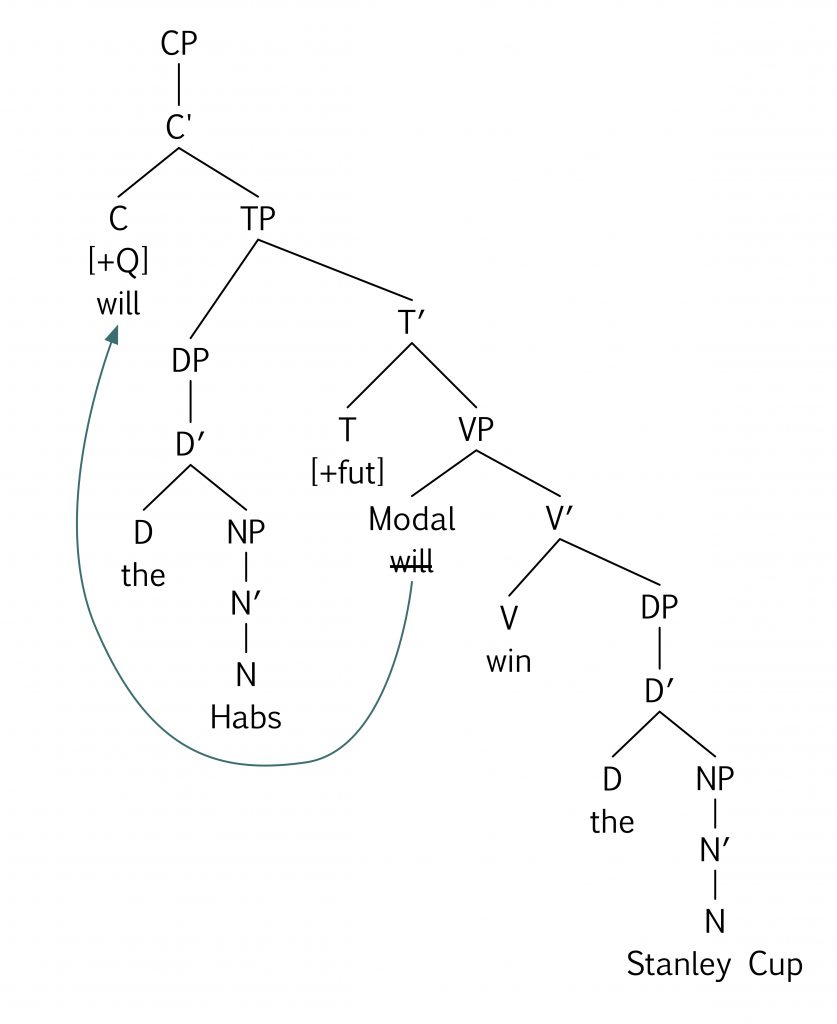
- Answer
-
The first one, with the movement of will from the T node to the C node.
The reason: This is part of forming a question, where we move the conjugated verb to the front of the phrase.
5.5.2: From 8.10 Wh-Movement, in Anderson's Essentials of Linguistics
Video Script
In the last unit, we extended our model of the syntax component of the mental grammar. The idea is that we draw words, morphemes and features from our mental lexicon, and the operation MERGE combines them using X-bar principles. The structure that MERGE generates is called a Deep Structure; it’s the underlying form of a sentence that we hold in our minds, but it’s not always exactly like the form that we speak out loud. For some sentences, a second operation, MOVE, takes some elements from the Deep Structure and moves them to another position in the Surface Structure.
The MOVE operation that we’ve seen so far takes a head and moves it to another head position, leaving a trace behind. For obvious reasons, this kind of movement operation is called head movement, and the primary job that head movement does is to form yes-no questions. For this question, Has Faiza eaten lunch yet?, there’s only a small set of possible answers that are grammatical: yes, no, I don’t know, maybe.
But of course, yes-no questions aren’t the only kinds of questions we ask in English. Take a look at these questions:
What is Ramesh cooking?
Who is he cooking for?
When is Leela arriving?
Where did he buy the ingredients?
Why is he making samosas?
How do they taste?
These questions don’t take Yes or No as their answers, they take phrases.
What is Ramesh cooking? Samosas.
Who is he cooking for? Leela.
When is Leela arriving? In an hour.
Where did he buy the ingredients? At the store.
Why is he making samosas? Because Leela loves them.
How do they taste? Delicious!
We call these wh-questions because most of the English words that we use in these questions are spelled with “wh”. Notice that how counts as a wh-word even though it doesn’t have the letter “w” in it.
What we’re observing here is the Surface Structures of these wh-questions. What might their Deep Structures be? To figure that out, let’s think about what the corresponding declarative sentence would be: imagine the situation where we’re answering each question with a full sentence.
Ramesh is cooking samosas.
He is cooking for Leela.
He bought the ingredients at the store.
Our theory claims that in the Deep Structure of a wh-question, the wh-phrase is generated in the position that it would occupy if it were the answer to the question. In other words, the Deep Structure of the sentence, What is Ramesh cooking is really, Ramesh is cooking what. That wh-word what is a pronoun that stands in for the Noun Phrase that refers to what he really is cooking. In the situation where we’re asking this question, we don’t know that the answer to the question is samosas, so we need a question word that lets us refer to the samosas without knowing their identity. The wh-word what does that job and the idea is that the structural relationship between the verb cooking and the pronoun what is the same as the structural relationship between cooking and samosas.
Let’s see how it looks in a tree diagram. Here’s the declarative sentence, Ramesh is cooking samosas. The samosas are the direct object: they’re the NP in the complement of the verb cooking. And in this declarative sentence, the Surface Structure and the Deep Structure are the same. But if we didn’t know what Ramesh was cooking, and we wanted to ask the question, MERGE generates a slightly different Deep Structure, like this.
Notice that the C-head contains a [+Q] feature because we’re going to be asking a question, and a [+wh] feature because the question is going to be a wh-question. Also notice that this wh-phrase, what, has a wh-feature on it too.
So do we form the surface structure by moving what up into the C-head position? There are two reasons that’s not going to work. The first is obvious: we know, from observing our own grammaticality judgments, that, What Ramesh is cooking is not the surface form of our sentence! And the second reason is for the sake of the theory: C is a head position, so it would mess up the consistency of our theory if we allowed a phrase to move into a head position. Besides, we’re going to need that C head position for something else very soon.
The landing site for wh-movement is a position we haven’t yet used, it’s the specifier of CP, sister to C-bar and daughter to CP. The idea is that moving a wh-phrase into the specifier of CP supports the wh-feature in C.
Now, of course, this still isn’t the right Surface Structure for this sentence. What still needs to happen? We still have this [+Q] feature in C-head that needs to get supported as well, so in this wh-question, in addition to the wh-movement of the wh-phrase up to the Specifier of CP, we also have head-movement of the auxiliary from V to T to C. And that leads to the grammatical Surface Structure, what is Ramesh cooking?
So we’ve now seen two different ways that the MOVE operation works. For head movement, it’s a head that moves, and it moves to another head position. For wh-movement, it’s a whole phrase that moves, and it ends up in the Specifier of CP. So when you’re depicting movement, always check that you’ve got the right kind of node moving to the right position.
Now it’s time for you to practice. Look back at these other wh-questions we generated. These are the Surface Structures of these questions. Try drawing trees to represent the Deep Structures of these sentences, and then draw the movement operations that generate the Surface Structure.
Check Yourself
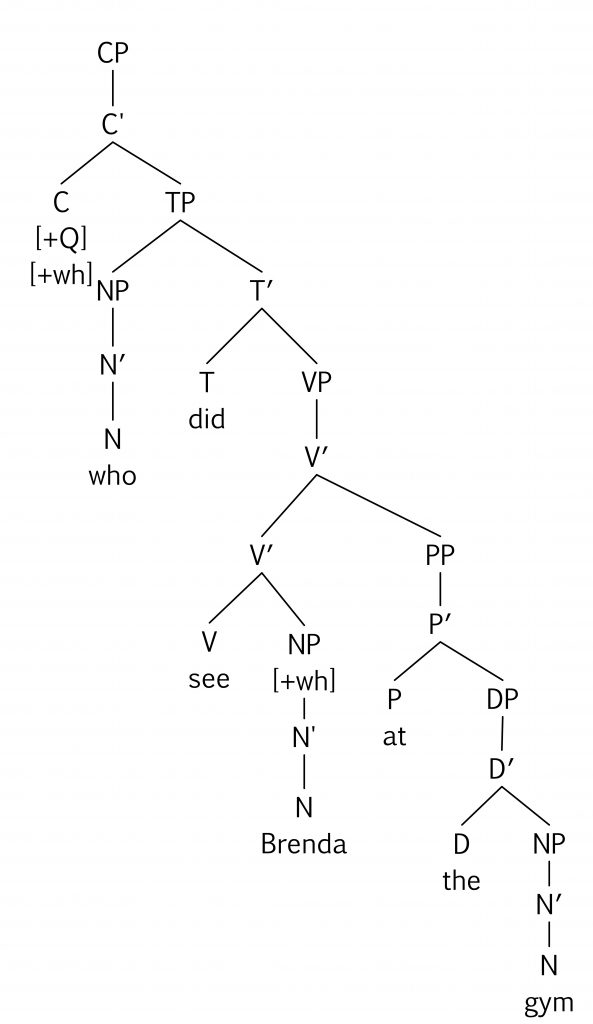
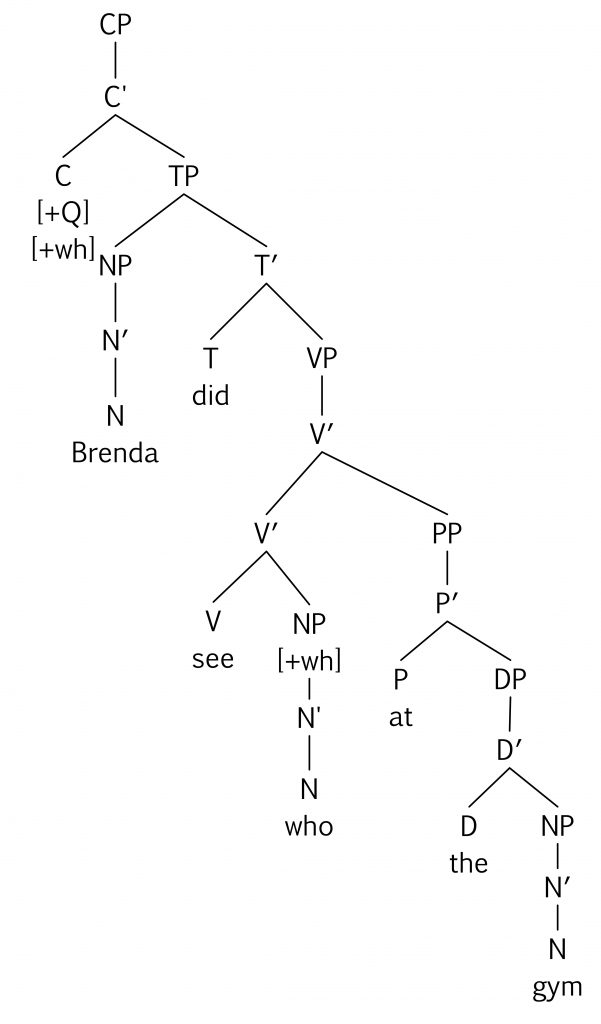
- Answer
-
The second one, where who comes out of the complement NP node to the verb see
The reason: The question is about the direct object, not the subject, of the verb.
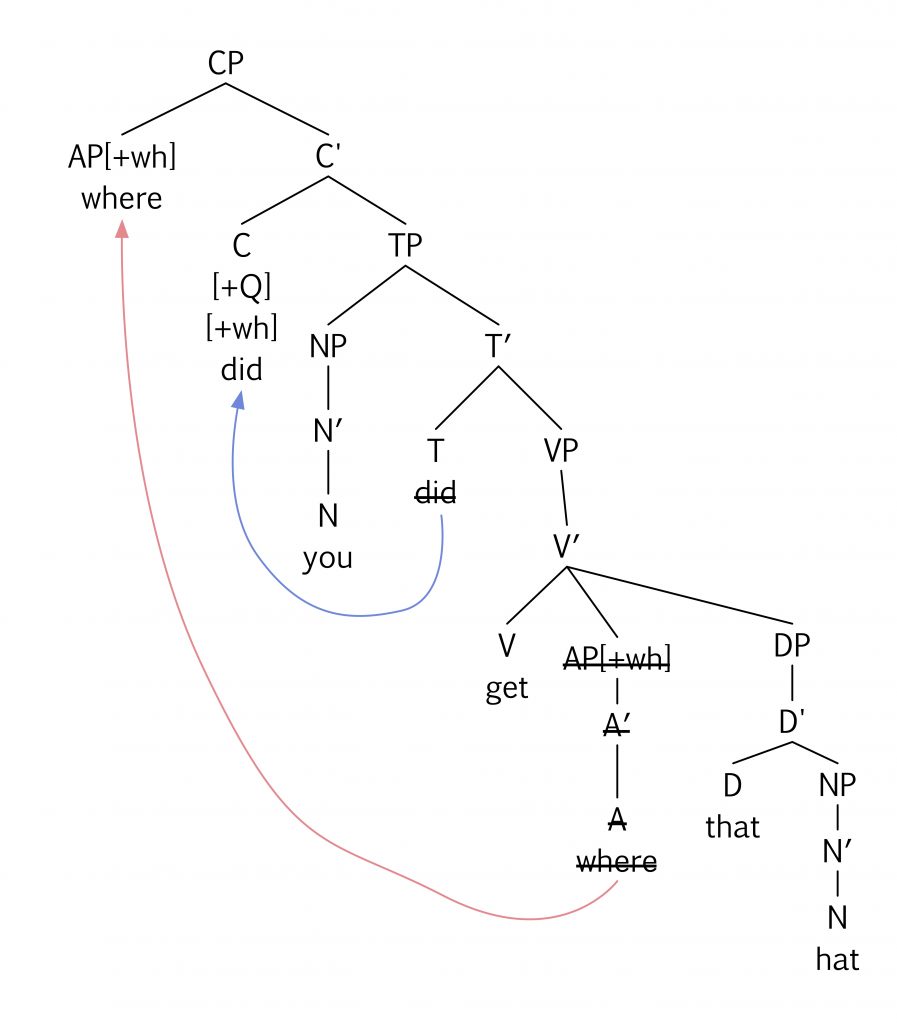
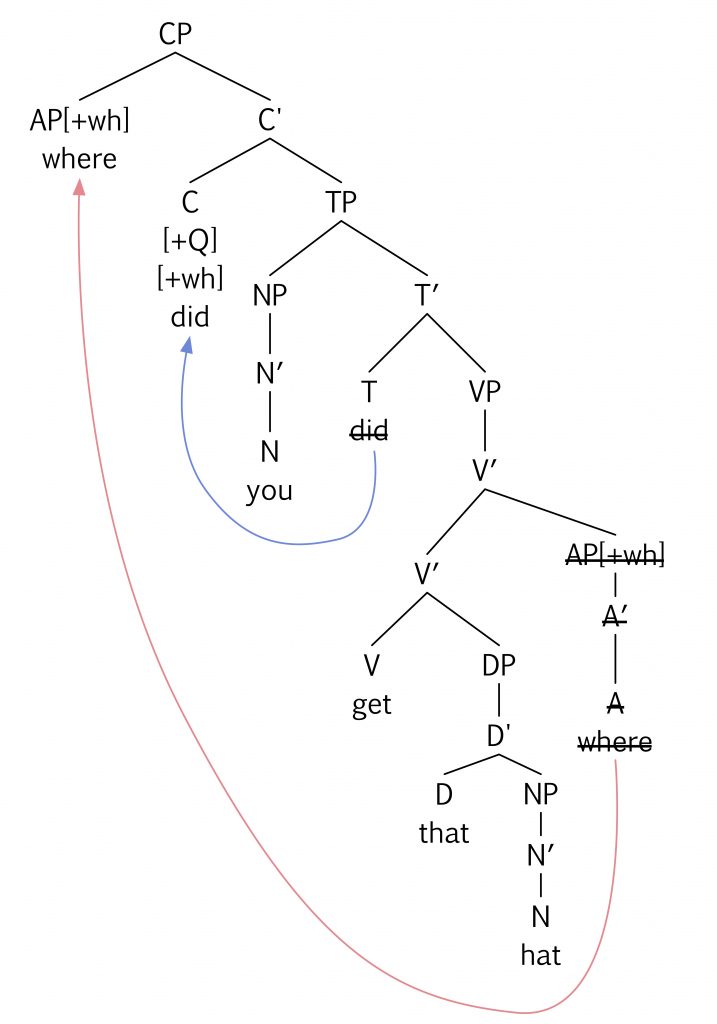
- Answer
-
The second one, with where coming out of the adjunct node off of the V'.
The reason: That information is an adjunct, not a complement, of the verb get.
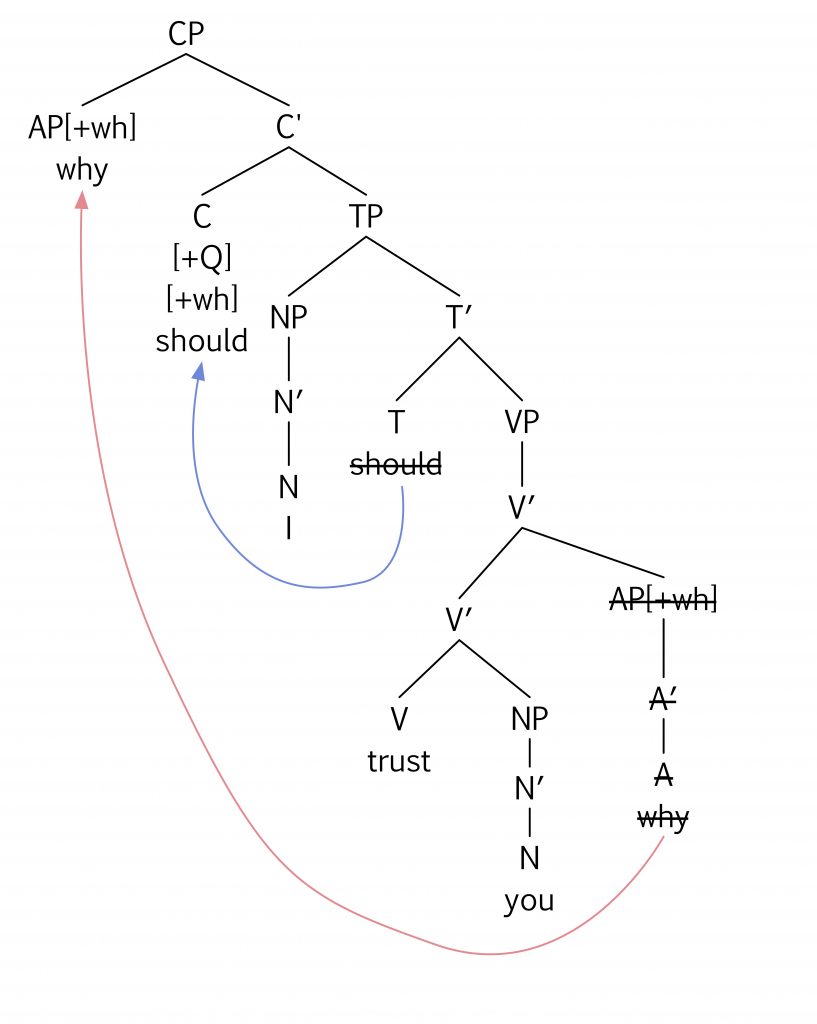
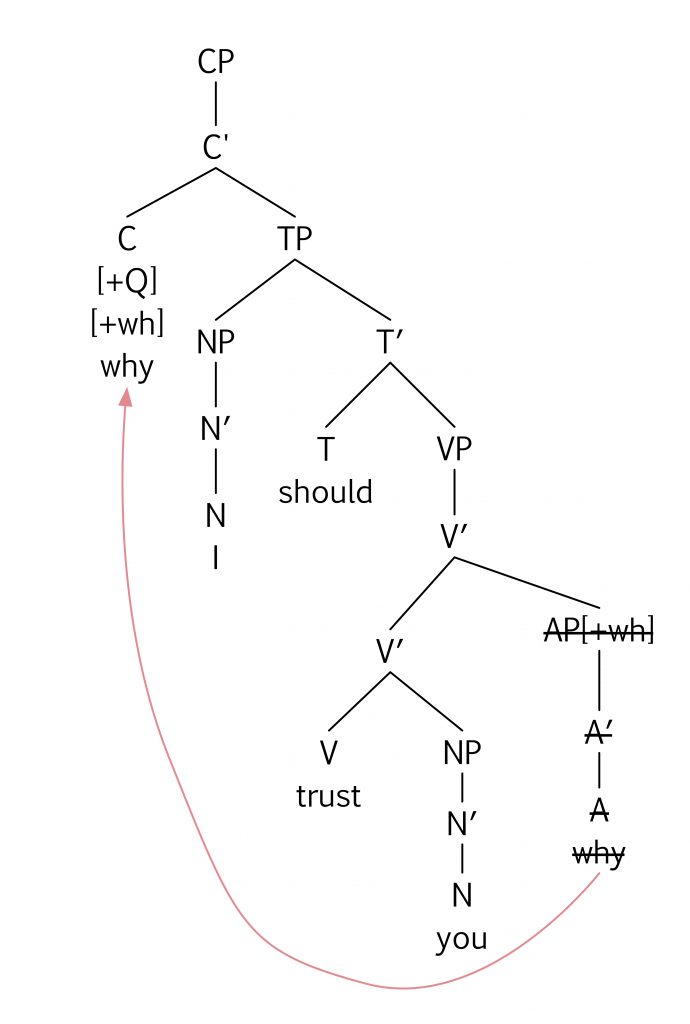
- Answer
-
The first one, with should coming out of the T node to the C node, and with why coming out of the adjunct node of the V'.
The reason: Both should and why move.
5.5.3: From 8.11 Do-Support, in Anderson's Essentials of Linguistics
When we form a question that includes a modal auxiliary, the modal moves from the T-head position to the C-head position:
Could you could read this for me?
When a sentence contains no auxiliary, only a lexical verb, it appears that the lexical verb cannot move out of its V-head position. So we’ve proposed that the auxiliary do enters at the T-head position and then moves up to the C-head position:
Did you did see her tattoo?
*Saw you saw her tattoo?
One piece of evidence that do enters the sentence at the T-head position and moves to C-head, rather than just entering at the C-head position, is that it bears the tense feature of the sentence: if the tense is [+past], then we observe the form did, but if the tense feature is [-past], we observe the form do or does. Another piece of evidence is that whatever verb follows the inserted do is in its bare form, not its [-past] or [+past] forms:
Did she talk to Darren?
*Did she talks to Darren?
*Did she talked to Darren?
Does she speak Italian?
*Does she speaks Italian?
*Does she spoke Italian?
Both of these observations suggest that the inserted do gets its tense morphology from the tense feature (either [+past] or [-past]) in the T-head.
Negation
English also uses do-support to form negated sentences, which follow the same pattern: sentences with modals don’t need do, but sentences with lexical verbs and no auxiliaries do need do:
I could not believe that rumour.
*I did not could believe that rumour.
*She speaks not Italian.
She does not speak Italian.
If we accept that not is in a fixed position between T-head and its VP-complement, then the distribution of do makes sense. Just like in questions, the evidence suggests that lexical verbs cannot move out of their V-head position up to the T-head position.
Non-modal auxiliaries
This pattern of how do behaves in questions and negative sentences gives us a clue about how the other non-modal auxiliaries, have and be, behave.
Notice that the verb be can always move up to C-head in questions, both when it’s a genuine auxiliary:
Are you are going to the concert?
Was she was joking about that?
And when it’s the only verb in the sentence:
Are you are serious?
Is this is the place?
Likewise, be appears before not both when it’s an auxiliary and when it’s the only verb:
You are not are going to the concert.
She was not was joking about that.
You are not are serious.
This is not is the place.
But have seems to have two different patterns of behaviour. When it is a genuine auxiliary, it behaves like be. It can move up to C-head in questions:
Have they have moved to Texas already?
Had she had already heard the news?
And appears before not in negated sentences:
They have not have moved to Texas already.
She had not had already heard the news.
But when have is the only verb in the sentence, it behaves like a lexical verb. It can’t move up to C-head and can’t appear before not.
*Has she has five sisters?
*Have you have a headache?
*She has not has five sisters.
*You have not have a headache.
Instead, when have is behaving like a lexical verb, it needs do-support.
Does she have five sisters?
Do you have a headache?
She does not have five sisters.
You do not have a headache.
The Deep Structures
From all of this evidence, we can conclude that MERGE treats these three kinds of heads differently:
Modals are generated in T-head, from where they can move to C-head if necessary to support a [+Q] feature.
Be is generated in V-head, but moves up to T-head (to the left of not) and from there up to C-head if necessary
Have is generated in V-head, and can move up to T-head and from there up to C- head only if it is an auxiliary (that is, only if it has a VP complement). But if it is the only verb in the sentence (and has no VP complement), then it behaves like a lexical verb.
Lexical verbs in English are generated in V-head and cannot move to T-head or C-head.
5.5.4 Grammatical Dependencies, from Sarah Harmon
Video Script
Catherine did an excellent job and describing all of those transformational rules that explain why things move around the way they, like for a passive sentence or a negation or a question or anything like that. I'm going to also add on a little bit more, and that has to do with some other ways that we can show dependency within the structure of any given language.
I'm going to start with something that is fairly straightforward in most other languages, just not so much in English. It's the concept of subject verb agreement. Native English speakers, if you learned a different language, with a few exceptions, this was something that really bugged you. This was an element that was difficult for you to pick up on. The reason why is because English does not have much in the way of inflection on verbs and, in particular, we do not have much with respect to subject verb agreement. It just isn't there. However, when we learn a language that does have it, it throws us for a loop. Sometimes Subject Verb Agreement is called Linear Agreement. it is a rule that states that there needs to be some kind of inflection on the verb to show some kind of match with the subject in some way, shape or form. Every language does things differently; in the case of English, we have a tendency, like I said, to have a little bit of inflection. For example, take P and Q. Krieger sees the box. We know this is correct, that this is the third person singular of the verb and that the subject is also third person singular. Compare that to Q: Lana and Sterling see the box. Notice that the inflection is not on the verb and that's because it is not a third person singular form.
I'll give you R and S, which show you pretty much the same thing in the case of is versus are, has versus have. English is not always the best example of this rule, but it is a little bit of as an example. Certainly, if you learn any other into European language—most every Finno-Ugric language, pretty much everything outside of the Sino-Tibetan languages and the various languages of Southeast Asia—chances are everything else will have some kind of linear agreement.
There's a second agreement rule that is very important to bring up and it's this one, Structure Dependent Agreement Rule. It basically states that a verb agrees in person and number with the subject of the sentence. The subject of the sentence is defined as the NP immediately dominated by the S node or the TP node, whichever version you want. Why is it that important? It explains why we have this linear agreement in the first place. We need to be able to tie in the morphology and the syntax together. Not only is it enough to in most languages have some kind of marker of some kind on the subject, you needed to agree in some way with the verb.
Let me show you some examples. I'm going to show you some examples of the same sentence in English, Spanish, Italian, Japanese and Hungarian. I picked those languages for a reason. Spanish because most all of you have some familiarity with it. Italian because, while it is sibling language of Spanish, the inflection is not always the same on the verb. I picked Japanese because it is an SOV language; it is definitely different, but you will see and hopefully observe a pattern with these endings and with the verb. Finally, I gave you Hungarian. Hungarian, as a Finno-Ugric language, is very interesting for a few reasons, and we'll come to those in a second.
If you want to say I watch the movie, in Spanish and Italian you do not have to use the pronoun for 'I', the first person singular pronoun, because it is baked into the verb. That verb form can only go with first person singular subjects. This means that you can leave off that yo or io, depending on which one you're talking about. You can leave it off because miro and vedo, respectively, tell you everything you need to know about who the subject is. But you do not have that with either Hungarian or Japanese. In the case of Japanese, the verb does not show much with respect to subject agreement. Because of that, you have to have the pronoun for 'I', and in this case the pronoun for 'I', watashi, has a case marker on it to show you that is also this subject So watashi-wa. In Hungarian, you have word order, and you have a verb that does not necessarily tell you who the subject is. Therefore, you do have to have the pronoun, which is marked for being the subject.
This is 'you-singular', and 'we', so first person plural, in the same exact sentences. The only difference is subject. so now, I want you to look at miro versus miras versus miramos. I want you to look at vedo, vedi, vediamo. I want you to look at miru, miru, miru—notice that this verb does not change it all, which is why we have the various forms in Japanese for the subject. But notice that Hungarian nézem, nézed, nézzük does change, but you still need the pronoun to go with it because it doesn't quite give you enough information.
Every language is going to play with this. For example, in Spanish and Italian, while you do not need the subject pronouns, that's why they're in parentheses, because the verb tells you everything. You can add it, but when you add the pronoun, you are being emphatic, or you are usually making some kind of contrast between the subject and someone else. You can say, for example in Italian io vedo il film, but you're really stressing that io, that 'I' and really what you're doing is you're saying, 'I watch the film; not them, not her, not you. I do’. But it's not commonly done. The third person singular and plural is a different story, because you need to know who the subject is. But the first and second person in most Romance languages, you don't need the subject pronoun; it's there it's already a part of the verb. On the other hand, you do not have that luxury in Japanese and you do not have that luxury of Hungarian because of other structural pieces that are there. That is to say, the structure dependent agreement rule states that the language needs to make some kind of ‘agreement handshake’. If it's not there, then you need to make it clear in some other way; either you need a case marker, or you need some other element in the language to show you who the subject is. Sometimes it's word order and sometimes it's just something else.

